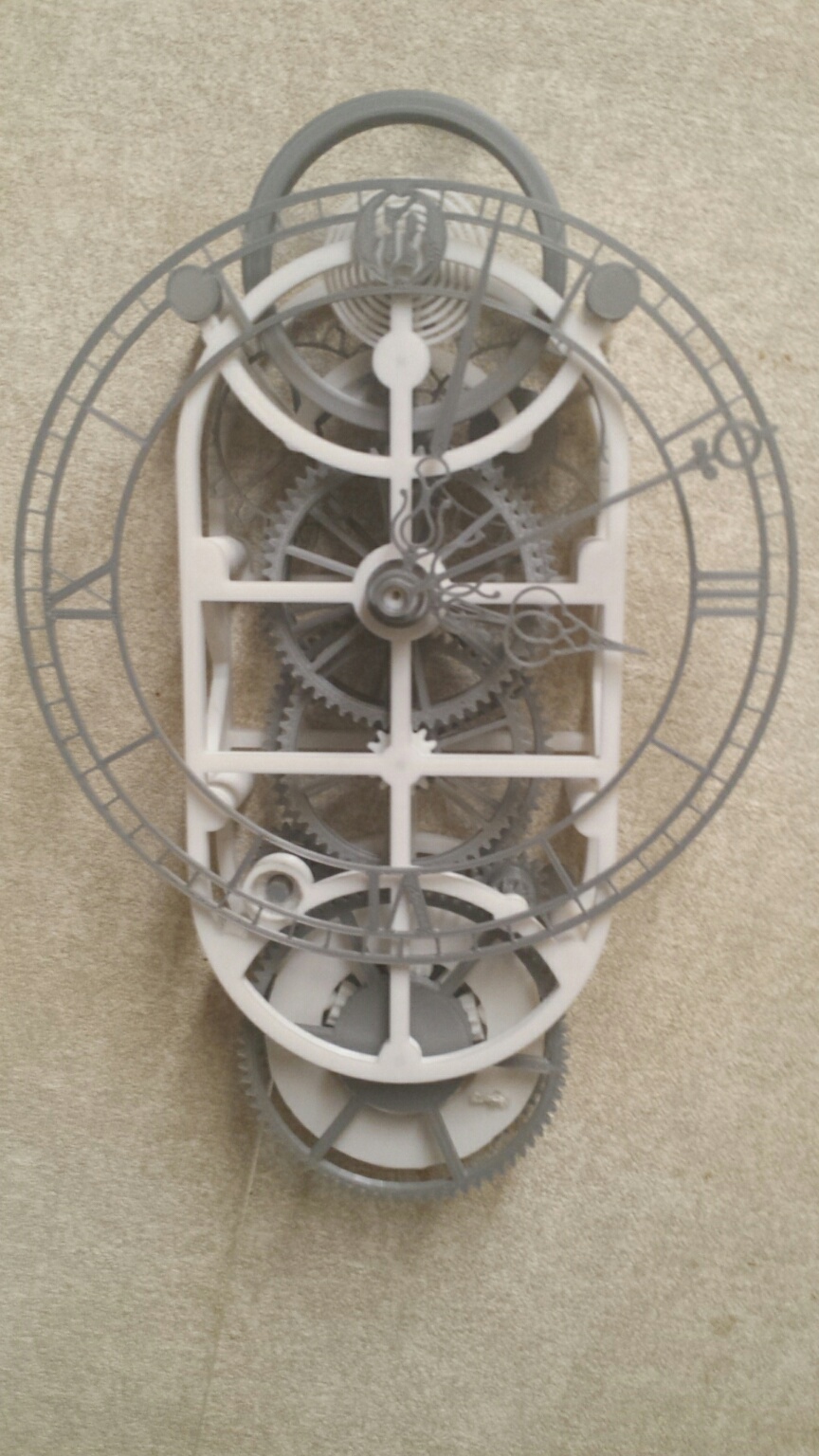
Clock (Dual Ulysse Escapement)
prusaprinters
<p>I decided to convert TheGoofy's excellent clock (<a href="https://www.thingiverse.com/thing:328569">https://www.thingiverse.com/thing:328569</a>) to one using a dual ulysse escapement. Designed by Ludwig Oeschlin, it is a modern take on Breguet's natural escapement. The promised gain in efficiency by virtue of its use of radial thrust is somewhat offset by the need to overcome the rotational inertia of two escape wheels rather than one. Ulysse Nardin minimized this problem through the use of silicon parts. I just made the wheels extra thin.</p> <p>Though I consider this a remix of TheGoofy's design, I ended up making all of the parts from scratch (though I suppose the pulley and weight carrier carry over). The frame ended up a bit larger but flatter. I also decided to toss in a differential winding drum. The clock seems to run quite well on 1.9kg of weight (though individual results will vary) for about six hours (with pulley)</p> <p>Non-printed materials include:<br/> 2mm x 16mm dowel pins<br/> 2mm x 34mm shafts<br/> 3mm x 34mm shaft<br/> 550 cord guts or any kind of thin cordage<br/> 1.75mm filament strips</p> <p>See it in action:<br/> <figure class="media"> <oembed url="https://www.youtube.com/watch?v=CfXuEa-WGOI"></oembed> </figure> </p> <p>See the assembly:<br/> <figure class="media"> <oembed url="https://www.youtube.com/watch?v=NLQmyOB7T1M"></oembed> </figure> </p> <h3>Print instructions</h3><p>Category: Mechanical Toys</p> <h3>Print Settings</h3> <p><strong>Printer:</strong> Reach 3D</p> <p><strong>Rafts:</strong> Doesn't Matter</p> <p><strong>Supports:</strong> Yes</p> <p><strong>Resolution:</strong> .15mm</p> <p><strong>Infill:</strong> 40</p> <p><strong>Filament:</strong> eSun PLA<br/> <strong>Notes:</strong></p> <h3>Printed on my Reach 3D printer and my Prusa i3 Mk3. The multi-colored nature of a few of the photographed parts demonstrates that the Prusa's filament detection and auto-pause feature works as advertised with no adverse effects on the gear train.</h3> <p>Originally submitted as an education project on Thingiverse. The portion below outlines various projects in which one can make use of this clock at all levels:</p> <h3> Overview and Background</h3> <p>Mechanical clocks since their inception utilize many different physical properties in order to tell time. Below are a few examples of how these fascinating mechanisms may be used to teach concepts in physics and engender interest in engineering. This clock demonstrates many different mechanical systems optimized over the long history of horology. From its unusual escapement down to the differential weight drum, all parts are exposed in the open frame design for easy observation and exploration.</p> <h3> Lesson Plan and Activity</h3> <p>The clock mechanism provides many teaching opportunities at all levels of study. Here are some sample problems and projects broken down by grade level:</p> <p>Elementary School:</p> <ul> <li>What gear ratios are used to create the 60:1 and 12:1 reductions? (division)</li> <li><p>The 60:8 and 64:8 have the same shaft distances and so must have differently sized teeth. What is the lowest number of gear teeth they could have to maintain their ratio with the same size teeth for the same shaft on center distance? (GCF/LCM)</p> <p>Middle School:</p> </li> <li><p>What is the run time on the clock given the dimensions of the drum and the gear ratios? (algebra/geometry/circles)</p> </li> <li>What is the volume of plastic in the clock face excluding the numerals? (geometry)</li> <li>Calculate the torque at each shaft (ignoring friction) (intro physics)</li> <li>Demonstrate rotational moment of inertia/coriolis effect with screws in the balance wheel (intro physics)</li> <li><p>Demonstrate the relationship between force and string length in pulley systems (intro engineering)</p> <p>High school:</p> </li> <li><p>What is the rotational moment of inertia of the balance wheel given its dimensions? (physics)</p> </li> <li>Given a few different balance springs and a single balance wheel, calculate the spring constants (there will always be slight variances no matter how consistent a printer is) from the observed period and known balance wheel properties. (physics)</li> <li><p>Discussion of involute vs. cycloidal gear tooth profiles. (CAD, intro engineering)</p> <p>University:</p> </li> <li><p>Calculate the stresses in the frame pieces (modelled as a pin-connected truss and with moment connections) (statics)</p> </li> <li>What is the minimum requirement for gear spoke dimensions given PLA material properties and a given amount of weight applying torque at the drum? (dynamics)</li> <li>Discuss/demonstrate thermal properties of PLA and how that affects the clock's accuracy/operation. (Materials science/physics)</li> <li>I want to use my clock as a space heater this winter. How efficiently does the clock convert the potential energy of the weight into thermal energy (friction) ie. calculate the efficiency of the escapement) (physics)</li> </ul> <h3> Materials Needed</h3> <p>Material requirements vary by project/problem. Here are a few:</p> <ul> <li>One or more clock models</li> <li>Additional springs and balance wheels (to teach springs/moment of inertia)</li> <li>Clock weights of varying sizes (to teach torque)</li> <li>Stopwatch (to measure timing with different balance configurations)</li> <li><p>Calipers (to measure dimensions)</p> <h3>Skills Learned</h3> </li> <li><p>Moment of Inertia</p> </li> <li>GCF/LCM</li> <li>Ratios</li> <li>Spring Constants</li> <li>Material Properties</li> </ul>
With this file you will be able to print Clock (Dual Ulysse Escapement) with your 3D printer. Click on the button and save the file on your computer to work, edit or customize your design. You can also find more 3D designs for printers on Clock (Dual Ulysse Escapement).
